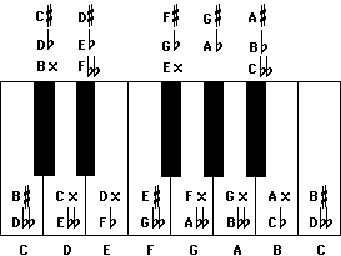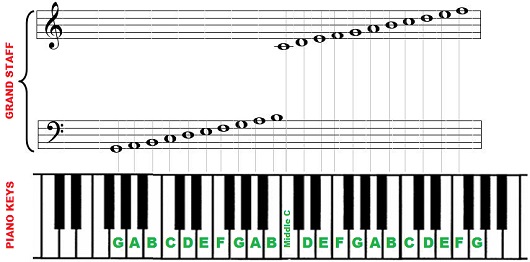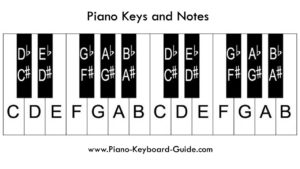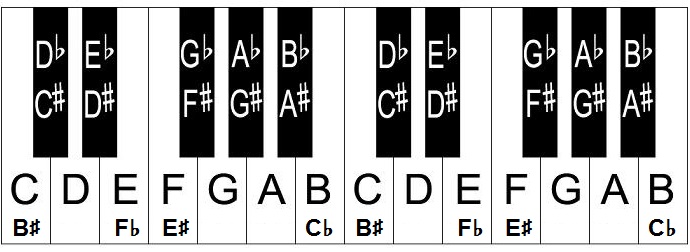In this lesson, we will take a look at piano notes and keys. You will learn the notes which correspond to the white piano keys as well as the black ones. I will show you how easy it is to label all the keys of your keyboard, no matter how many it has. This includes 88-key, 76-key, 61-key, 49-key and other keyboards.

Take a look at the unlabeled piano keyboard diagram above. Do you see the pattern of the black keys? If you look closely, you will notice that the black keys follow a pattern of twos and threes. It’s a pattern of two black keys followed by three black keys, followed by two black keys, followed by three black keys and so on. The same applies to every piano keyboard.
Location of C:
The first note we shall find is the note, C. What key plays the note, C on your keyboard? C is played with the white key that comes immediately before a set of two black keys. In other words, the key that is to the immediate left of a set of two black keys plays the note, C. There are several C notes on your keyboard. Every white key that comes immediately before a set of two black keys plays C.
Highly Recommended: Click here for the BEST piano/keyboard course I’ve come across online.
Watch corresponding video:
As a beginner, there is an important note that you should know. It’s called middle C. How do you find middle C on the 88 key piano? Sit at the center of your piano. The C which is below your chin plays the note, middle C. Middle C is not exactly in the middle of the keyboard, but it’s the centermost C. In sheet music, middle C is the note halfway between the bass clef and the treble clef.
Piano notes are named after the first seven letters of the alphabet. These notes are (obviously) A, B, C, D, E, F and G. These are the notes of the entire musical alphabet. There is no H. A B C D E F G keeps repeating.
Now that you know where C is located, it’s easy to find the other notes. Move to the next white key. That key plays the note, D. The next key plays E. keep going in alphabetical order to F, then G, followed by A. You will notice that we went back to the start of the alphabet. From G we went back to A. Finally, after A, we move to B. You can continue going to C, D, E, F, G, A, B, C, D, E, F, G and so on until you run out of keys. C-D-E-F-G-A-B are called naturals because they contain no sharps or flats which we shall learn more about later.
Location of F:
F is located before a set of three black keys. Every key before a set of three black keys on your piano keyboard plays the note F. Now that you’ve found F, it’s easy to label the other white keys. Simply move in alphabetical order to G, A, B, C, D, E and back to F.
How about the black keys? What are their names? Or to be a bit more precise, what notes do they play? Like the white keys, the black keys are named after the first seven letters of the alphabet except for the fact that they can be either sharp or flat.
Simply put, sharp means to go higher or to move to the right on your keyboard. Sharp suggests that you should play the key that is to the immediate right of a key. For instance, C sharp means to play the key that is to the immediate right of C. C sharp is a half step (or semitone) higher than C. Sharp is represented by the symbol, ♯ or #.
In simple terms, flat means to go lower or to move to the left on your keyboard. Flat suggests that you should play the key that is to the immediate left of a key. For instance, D flat means to play the key that is to the immediate left of D. D flat is a half step (or semitone) lower than D. Flat is represented by the symbol, ♭ or b.
Once again, what is the key to the immediate right of C called? The answer is C sharp (C#). This key can also be called D flat (Db) because it is one key to the left of D. The next black key is called D sharp (D#) or E flat (Eb). Then we move to F sharp (F#) or G flat (Gb), G sharp (G#) or A flat (Ab) and lastly A sharp (A#) or B flat (Bb). As is the case with the white piano keys, the pattern keeps repeating. After B flat (Bb), the next black key plays C sharp (or D flat), D sharp (or E flat) and so on.
Highly Recommended: Click here for the BEST piano/keyboard course I’ve come across online.
What we’ve talked about so far is really a simplified approach to looking at piano notes. In reality piano notes and piano keys are not the same. Each key of the piano can represent several notes. Strictly speaking piano keys don’t really have names. Keys aren’t actually called C, D, E, F, G, etc. They just play those notes. The same keys play other notes as well. This is important to understand especially when one is learning to read music, as well as musical scales.
The piano diagram above shows the various piano notes that piano keys usually correspond to.
Earlier, we saw that a piano key has more than one note name. A better way to put this is that one piano key can play more than one note. For example, the key that plays D flat can also play C sharp. When keys play more than one note, the notes are called enharmonic equivalents. So D flat and C sharp are enharmonic equivalents. The same can be said of D sharp and E flat. These enharmonic equivalents are played by the same key on the piano keyboard and sound the same on piano, but can have different note names depending on the key signature and other factors.
Even white keys have enharmonic equivalents. The key that plays C can also play B sharp (B#) since B# is one half step higher than B. The piano key that plays F can also play E sharp (E#) since E# is one half step higher than E. The key that plays E can also play F flat (Fb) since Fb is one half step lower than F. Learn more about half steps, whole steps, tones, semitones, sharps and flats here.
Sometimes a piano note can be called a double flat or double sharp, or even a triple sharp or flat. For instance, D is two semitones lower than E and the key that plays D can also play E double flat (Ebb). Double sharps and flats and triple sharps and flats are not as common.
Here’s a diagram of a piano keyboard, showing enharmonics.
The sign which looks like the letter “x” is a double sharp sign. The sign which looks like two flat signs side-by-side is a double flat.
Full 88 key piano keyboard diagram
On an 88 key piano, the lowest key (first note) is an A. There are 8 Cs. The last note is C. There are 52 white and 36 black keys. Here’s an image of piano notes on an 88 key piano: Click here for a picture of an 88 key piano keyboard layout.
Piano Notes Chart
The chart below shows you the notes on the grand staff, and where they are on the piano. Learn how to read piano notes here.
My new book will teach you how to read music. Go here to check out my book, “How To Read Music Fast, A 4-Step Beginner’s Guide To Reading Music Quickly and Easily”.
Related Pages (Piano Notes and Basic Music Theory):
- Notes Chart for Piano
- Piano Keyboard Layout
- Piano Key Chart
- Difference between Notes and Keys on Piano
- The Whole Note
- The Half Note
- The Quarter Note
- The Eighth Note
- The Sixteenth Note
- The Whole Rest
- The Half Rest
- The Quarter Rest
- The Eighth Rest
- Dotted Notes
- The Sharp Sign
- The Natural Sign
- Music Note Names
- What is the difference between sharp and flat?
Return from Piano Keys and Notes to home page.

